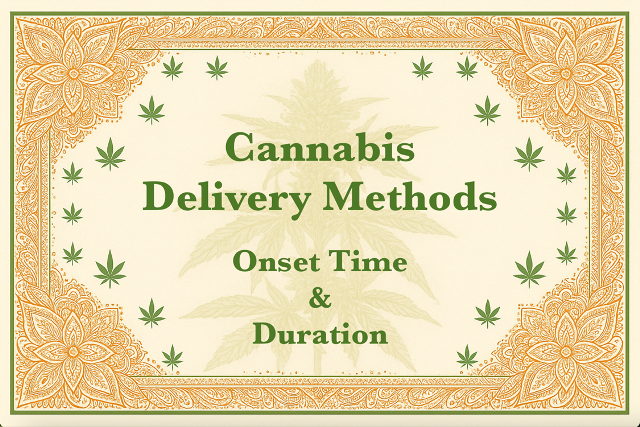
Cannabis consumption has evolved far beyond traditional smoking, offering a wide array of methods to suit diverse needs, preferences, and lifestyles. Whether seeking the benefits of THC or CBD, users can choose from inhalation, oral, sublingual, topical, and even medically delivered systems. Each method varies significantly in onset time, duration of effects, and intensity, making it crucial for both medical and recreational users to understand their options.
The chart below presents a comprehensive overview of these consumption methods to help guide informed and responsible use.
|
Method |
Category |
Form |
Onset Time |
Duration |
Notes |
|
Smoking |
Inhalation |
Dried flower |
1 – 3 min. |
1 – 3 hrs. |
Fast-acting, traditional, may be harsh on lungs |
|
Vaping |
Inhalation |
Flower or oil concentrates |
1 – 3 min. |
1 – 3 hrs. |
Discreet, less harsh than smoking |
|
Dabbing |
Inhalation |
THC/CBD concentrates (wax, shatter, resin) |
1 – 3 min. |
1 – 3 hrs. |
Potent, for experienced users |
|
Edibles |
Oral |
Infused food or drink |
30 – 90 min. |
4 – 8+ hrs. |
Long-lasting, hard to dose |
|
Capsules/Pills |
Oral |
Pre-measured gel caps |
30 – 90 min. |
4 – 8+ hrs. |
Discrete and consistent |
|
Cannabis Beverages |
Oral |
Infused drinks |
15 – 60 min. |
2 – 6 hrs. |
Easy to consume, trendy |
|
Tinctures |
Sublingual |
Alcohol or oil-based drops |
15 – 45 min. |
2 – 6 hrs. |
Fast-acting, discreet |
|
Sprays |
Sublingual |
THC/CBD spray |
15 – 45 min. |
2 – 6 hrs. |
Portable, user-friendly |
|
Topicals |
Topical |
Creams, lotions, balms |
15 – 30 min. |
Varies |
Localized effects |
|
Transdermal Patches |
Topical |
Patch infused with cannabinoids |
30 – 60 min. |
Up to 12+ hrs. |
Steady release, discreet |
|
Suppositories |
Rectal/Vaginal |
Infused with THC/CBD |
10 – 30 min. |
4 – 8 hrs. |
Bypasses digestion, “niche” use |
|
Inhalers |
Medical Inhalation |
Metered-dose THC/CBD |
Sec./Min. |
2 – 4 hrs. |
Precise and clinical |
Here are further descriptions of each delivery method along with forms of use, onset and duration times, along with pros and cons. The more you know, the more informed choices you can make.
a. Smoking
b. Vaporization (Vaping)
a. Edibles
b. Capsules or Pills
c. Beverages
a. Tinctures and Oils
b. Oral Sprays
a. Creams, Balms, Salves, Lotions
b. Transdermal Patches
a. Suppositories
a. Dabbing Concentrates
Here’s a reference list for the methods of cannabis (THC and CBD) administration, categorized for clarity:
Inhalation Methods
|
Method |
Description |
Onset Time |
Duration |
Notes |
|
Smoking |
Burning cannabis flower in joints, pipes, or bongs |
1–3 min. |
1–3 hrs. |
Traditional and fast-acting |
|
Vaping |
Heating cannabis flower or oil without combustion |
1–3 min. |
1–3 hrs. |
Less harsh on lungs than smoke |
|
Dabbing |
Flash vaporization of concentrates (e.g., shatter, wax) |
1–3 min. |
1–3 hrs. |
Potent; requires special gear |
Oral Ingestion
|
Method |
Description |
Onset Time |
Duration |
Notes |
|
Edibles |
Cannabis-infused food and drinks |
30–90 min. |
4–8+ hrs. |
Hard to dose accurately |
|
Capsules |
Pre-measured THC/CBD pills |
30–90 min. |
4–8 hrs. |
Convenient and discreet |
|
Drinks |
Cannabis-infused beverages |
15–60 min. |
2–6 hrs. |
Increasingly popular |
Sublingual / Buccal
|
Method |
Description |
Onset Time |
Duration |
Notes |
|
Tinctures |
Dropped under the tongue |
15–45 min. |
2–6 hrs. |
Faster than edibles |
|
Sprays |
Sprayed into mouth lining |
15–45 min. |
2–6 hrs. |
Portable and discrete |
Topical and Transdermal
|
Method |
Description |
Onset Time |
Duration |
Notes |
|
Creams/Lotions |
Applied to skin |
15–30 min. |
Varies |
Localized, convenient |
|
Patches |
Stuck to skin, slow release |
30–60 min. |
Up to 12+ hrs. |
Enters bloodstream, long-lasting |
Rectal & Vaginal
|
Method |
Description |
Onset Time |
Duration |
Notes |
|
Suppositories |
Inserted rectally or vaginally |
10–30 min. |
4–8 hrs. |
Bypasses digestive system, inconvenient |
Medical Inhalers
|
Method |
Description |
Onset Time |
Duration |
Notes |
|
Inhalers |
Metered-dose THC/CBD devices |
Sec/Min. |
2–4 hrs. |
Precise, used in clinical settings |
Understanding the full spectrum of cannabis consumption methods empowers consumers to make choices that align with their health goals, comfort levels, and legal contexts. From fast-acting inhalation techniques to long-lasting edibles and non-psychoactive topicals, each form offers unique benefits and considerations. As research continues to advance and product innovation grows, there are more tools than ever to tailor Cannabis Phytotherapy with precision and safety in mind.
Sources:
Cannabis and Cannabinoid Research (Mary Ann Liebert, Inc. publishers)
https://www.liebertpub.com/overview/cannabis-and-cannabinoid-research/634/ Scientific journal focused on cannabis-related health research.
Journal of Cannabis Research
https://jcannabisresearch.biomedcentral.com Peer-reviewed studies on pharmacokinetics of cannabinoids.
Leafly
https://www.leafly.com Trusted industry guide with user-friendly explanations of THC/CBD products.
Mayo Clinic – Medical Cannabis Information
https://www.mayoclinic.org Provides patient guidance on medical cannabis forms and uses.
Medical Jane
https://www.medicaljane.com Educational resource on safe and effective cannabis use.
National Center for Complementary and Integrative Health (NCCIH)
https://www.nccih.nih.gov Offers research-based overviews on CBD and THC effects and delivery mechanisms.
Project CBD
https://www.projectcbd.org Education-focused nonprofit with thorough breakdowns of delivery methods.
PubMed / NIH Database
https://pubmed.ncbi.nlm.nih.gov Research papers detailing bioavailability and onset times for various methods.
Cannabis Education Center – Introduction – Healing Properties – Index of 50 CBD & THC Strains & thier Terpenes – Cannabis Delivery Methods – Videos